Personal Care Product Use in Pregnancy and the Postpartum Period: Implications for Exposure Assessment
Abstract
:1. Introduction
2. Methods
2.1. Study Population
2.2. Data Collection
2.3. Data Analysis
| PCP Category | Examples of PCPs Included | Abbreviated Name | Leave on Category | Rinse off Category |
|---|---|---|---|---|
| Baby Lotions, Soaps and other Baby Products | Wipes, diaper ointment, baby body wash, petroleum jelly | “babyprod” | NA | NA |
| General Makeup and Cosmetics | Blush, foundation, concealer | “makeup” | X | |
| Lip Products | lip balm, lipstick, lip gloss | “lip” | X | |
| Eye Makeup and Cosmetics | Eye shadow, mascara, brow liner | “eyemakeup” | X | |
| Hairstyling Products | Hairspray, gel, mousse, hair paste | “hair” | X | |
| Nail Polish and Remover | nail polish, nail polisher remover | “nail” | X | |
| Fragrance and Perfumed Products | perfume, bubble bath, body mist, air freshener | “frag” | X | |
| Deodorant and Antiperspirants | Deodorant, antiperspirant | “anti” | X | |
| Body Lotions, Creams and Oils | Body butter, belly oil, sunscreen, hand cream | “lotion” | X | |
| Face Lotions and Creams | Day cream, night lotion, acne cream, eye moisturizer | “face” | X | |
| Body Soaps | Body wash, body gel, shower soap | “bodysoap” | X | |
| Facial Soaps, Cleansers and Washes | Face cleanser, exfoliator, face masks, eye makeup remover | “skinclea” | X | |
| Toothpaste and Mouthwash | Toothpastes, dental rinse, mouthwash | “oral” | X | |
| Hand Soaps, Sanitizers and Soap Not Otherwise Specified (NOS) | Liquid soap, bar soap, waterless sanitizers *, generic soap | “soap” | X | |
| Shampoo | Shampoo | “shampoo” | X | |
| Conditioner | Rinse-off conditioner, 2-in-1 shampoo and conditioner, leave-in conditioner | “condit” | X |
| Characteristic | n (%) |
|---|---|
| Age | |
| <30 years | 17 (21.25) |
| 30–34 years | 37 (46.25) |
| 35–39 years | 19 (23.75) |
| ≥40 years | 7 (8.75) |
| Highest level of Education Completed | |
| High school diploma | 9 (11.15) |
| College diploma | 14 (17.5) |
| University degree | 36 (45) |
| Advanced degree | 21 (26.26) |
| Marital Status | |
| Married | 63 (78.75) |
| Other | 17 (21.25) |
| Household Income | |
| <$60,000 | 7 (8.75) |
| $60,001–$80,000 | 11 (13.75) |
| $80,001–$100,000 | 13 (16.25) |
| ≥$100,000 | 44 (55) |
| Don’t know or declined | 5 (6.25) |
| Country of Birth | |
| Canada | 63 (78.75) |
| Other | 17 (21.25) |
| Employed | |
| Yes | 66 (82.5) |
| No | 14 (17.5) |
| Parity | |
| 0 | 37 (46.25) |
| 1 | 34 (42.5) |
| 2+ | 9 (11.25) |
| Pre-pregnancy body mass index (BMI) | |
| Underweight/normal | 50 (70.42) |
| Overweight/Obese | 21 (29.58) |
| Mean (SD) | |
| Height (cm) | 165.4 (7.3) |
| Pre pregnancy weight (kg) | 66.5 (13.2) |
3. Results
3.1. Demographics
3.2. Personal Care Product Use
3.2.1. Total Number of PCP Applications
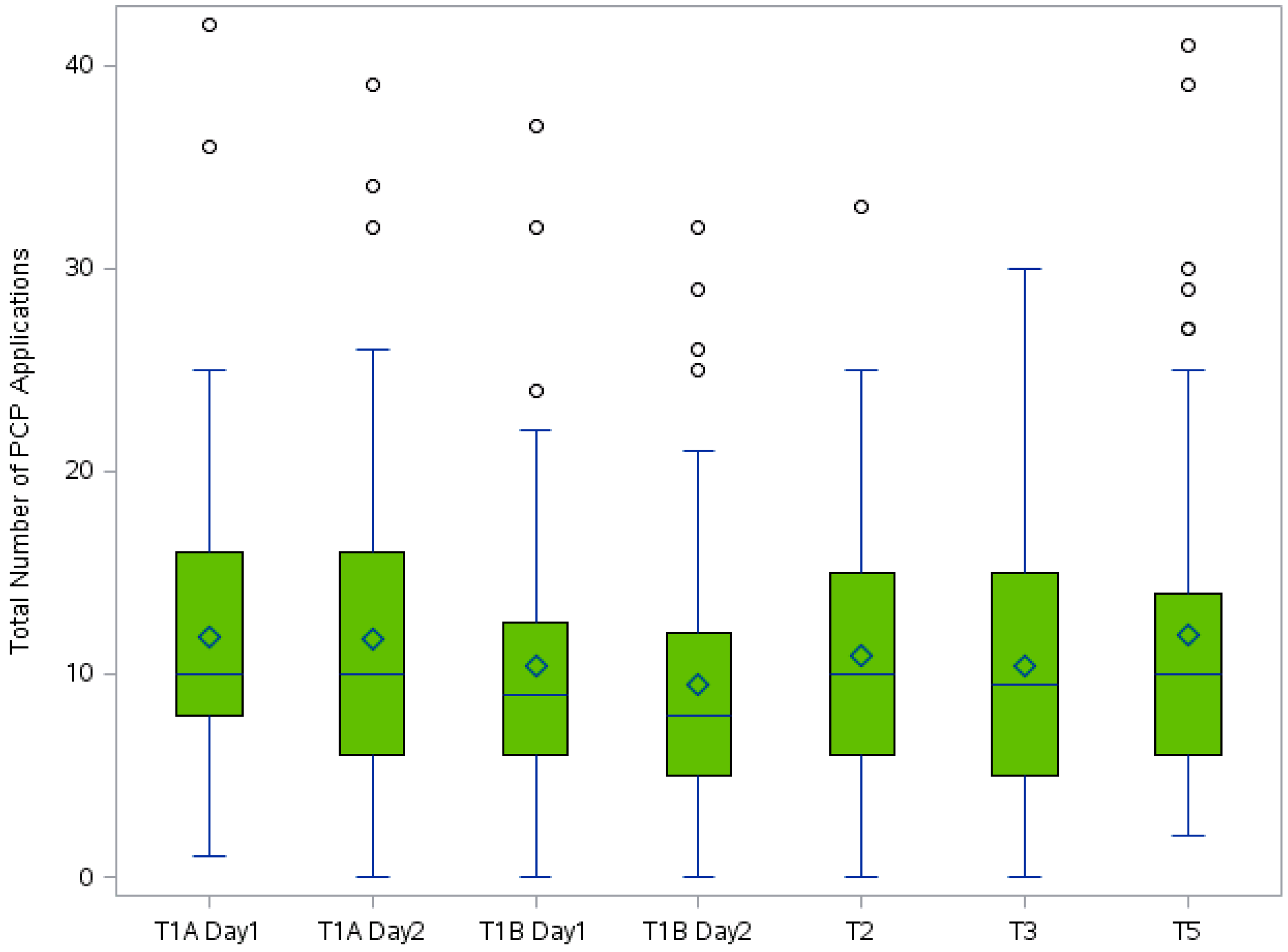
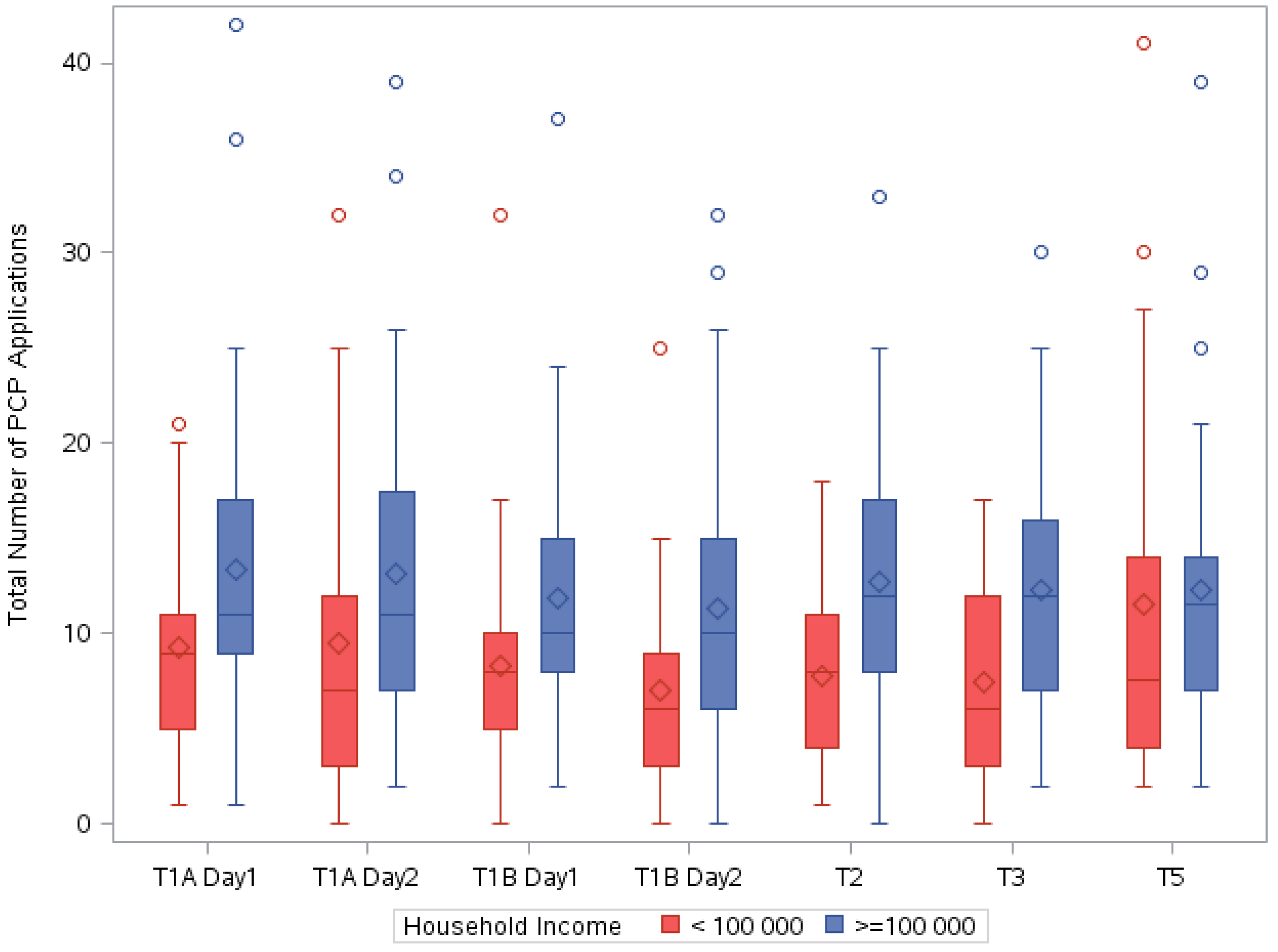
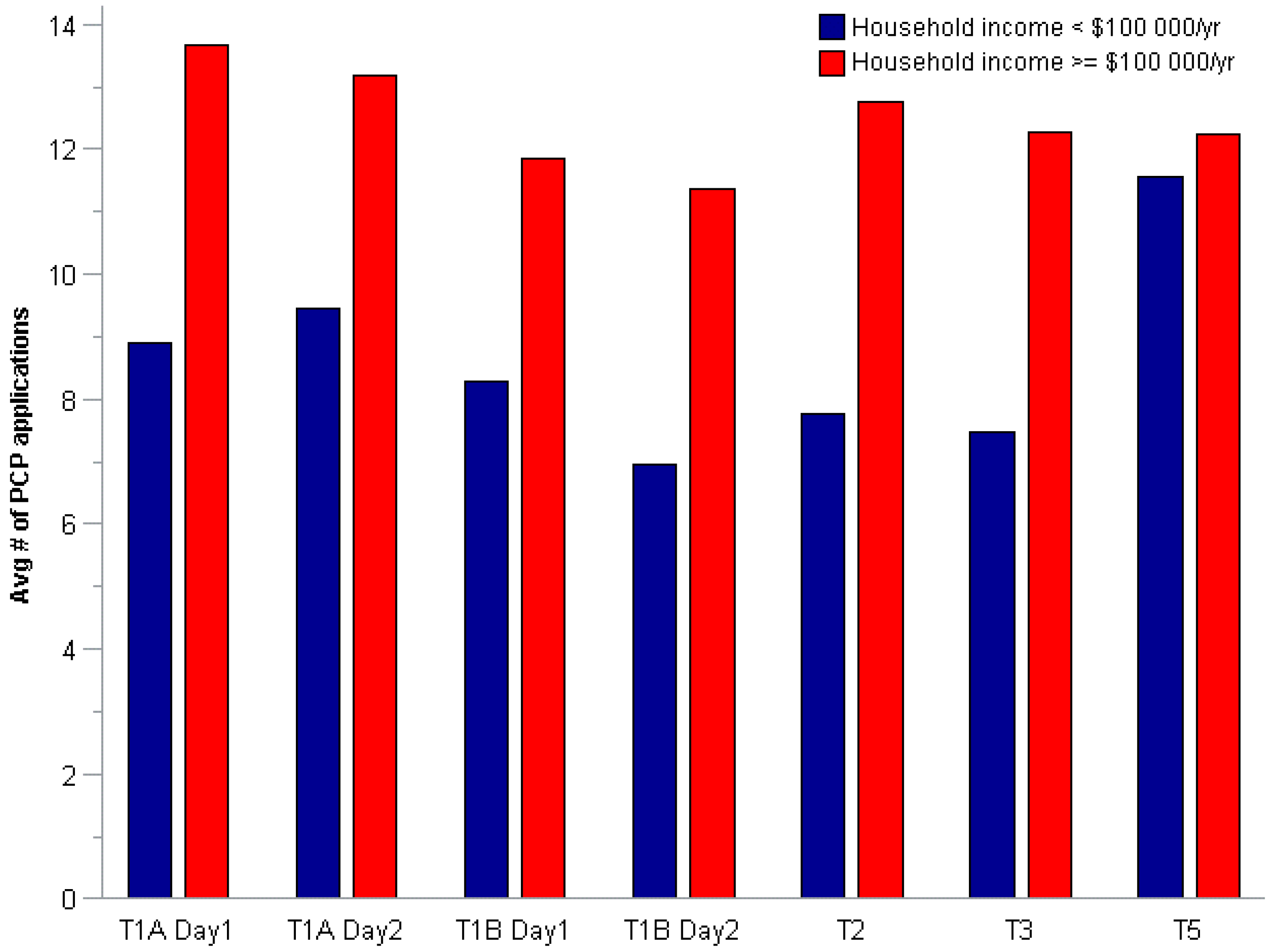
3.2.2. Prevalence of Use


3.2.3. Frequency of Use

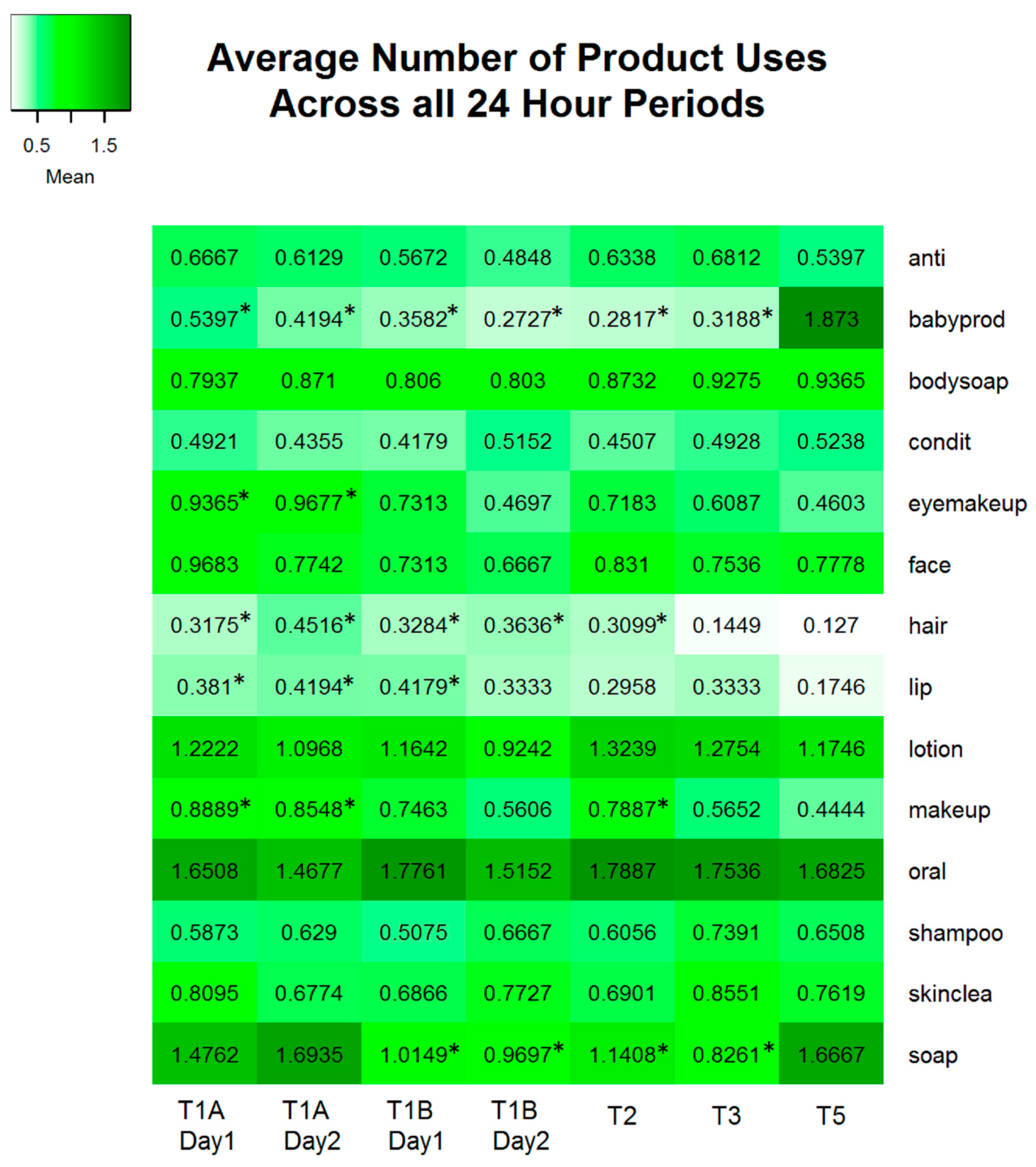
3.2.4. Co-Use Patterns
3.2.5. Cluster Analysis

| Combinations | N (80) | % | |
|---|---|---|---|
| Daily | SH + O | 73 | 91.3 |
| SH + O + BS | 68 | 85.0 | |
| SH + O + BS + A | 56 | 70.0 | |
| SH + O + BS + A + C | 45 | 56.25 | |
| SH + O + BS + A + C + SO | 32 | 40.0 | |
| Luxury | F + LO | 46 | 57.5 |
| F + LO + SK | 34 | 42.5 | |
| Daily + Luxury | SH + O + BS + A + C + SO + F + LO + SK | 18 | 22.5 |
| Beauty | M + EM | 30 | 37.5 |
| M + EM + LI | 18 | 22.5 | |
| M + EM + LI + H | 12 | 15.0 | |
| All product categories | SH + O + BS + A + S + F + C + LO + SK M + EM + LI + H | 7 | 8.75 |


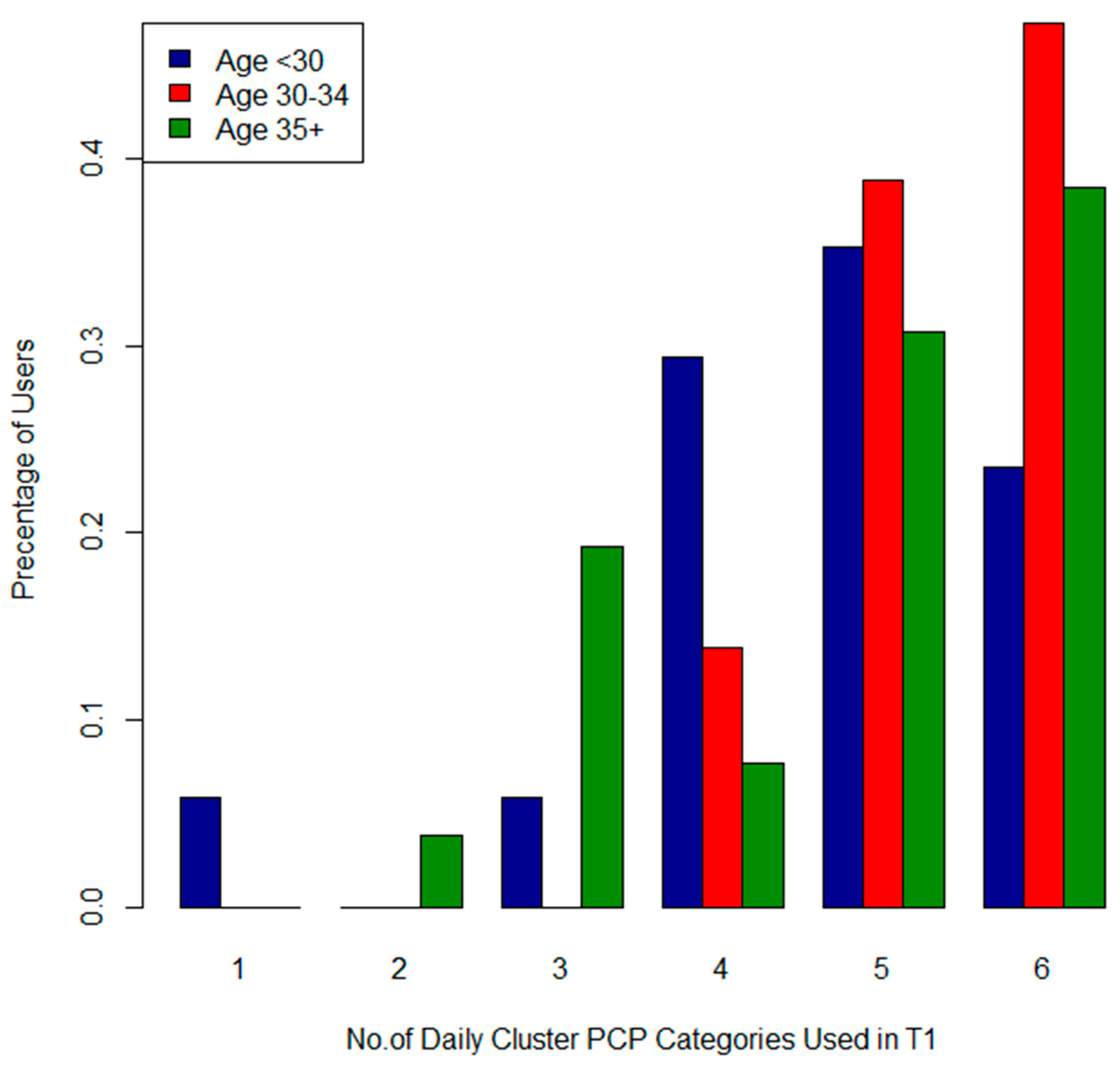
4. Discussion
| P4 Study 1 | T1A (n = 63) | T1B (n = 67) | Buckley et al. [16] (n = 50) 2 | Just et al. [17] (n = 186) 3 | Meeker et al. [18] (n = 105) 4 | ||||||||
|---|---|---|---|---|---|---|---|---|---|---|---|---|---|
| Product Category | N | % | N | % | Product Category | N | % | Product Category | N | % | Product Category | N | % |
| Lip Products | 20 | 31.8 | 23 | 34.3 | Lip Products | 42 | 84 | - | - | - | Colored Cosmetics | 95 | 90.5 |
| Eye Makeup and Cosmetics | 30 | 47.6 | 28 | 14.9 | Eye cosmetics | 33 | 66 | - | - | - | - | - | - |
| Hair Styling Products | 24 | 38.1 | 22 | 32.8 | Hair styling products 5 | 33 | 66 | Hair gel | - | 25 | - | - | - |
| - | Hairspray | 26 | 56 | Hairspray | - | 10 | Hairspray | 47 | 44.8 | ||||
| Shampoo | 55 | 87.3 | 56 | 83.6 | - | - | - | - | - | - | Shampoo | 97 | 92.3 |
| Conditioner | 44 | 69.8 | 45 | 67.2 | Hair Conditioner | 29 | 58 | - | - | - | Conditioner | 97 | 92.3 |
| Body soap | 54 | 85.7 | 53 | 79.1 | - | - | - | - | - | - | Bar soap | 99 | 94.2 |
| Hand Soaps, Sanitizers and Soap NOS | 42 | 66.7 | 37 | 55.2 | - | - | - | Liquid hand soap | - | 29 | Liquid soap 6 | 103 | 98.1 |
| Deodorant and Antiperspirants | 49 | 77.8 | 42 | 62.7 | - | - | - | Deodorant | - | 98 | - | - | - |
| Body Lotions, Creams and Oils | 41 | 65.1 | 50 | 74.6 | Hand cream or lotion | 43 | 86 | Lotion | - | 82 | Hand and Body Lotion | 95 | 90.5 |
| - | Other cream or lotion | 33 | 66 | - | - | - | - | - | - | ||||
| Baby Products | 21 | 33.3 | 17 | 25.4 | Baby products | 18 | 36 | - | - | - | - | - | - |
| Fragrances and Perfumed Products | 9 | 14.3 | 7 | 10.5 | Perfume or cologne | 28 | 56 | Perfume | - | 41 | Perfume/Cologne | 93 | 88.6 |
| Nail Polish or Remover | 0 | 0 | 1 | 1.5 | Nail polish or remover | 8 | 16 | Nail polish or remover | - | 10 | Nail polish | 58 | 55.2 |
| Product Category | Loretz et al. [7,8,9] | Product Category | P4 Study T2 | ||||||||||
|---|---|---|---|---|---|---|---|---|---|---|---|---|---|
| N 1 | Mean | SD | Med | Min | Max | N 1 | Mean | SD | Med | Min | Max | ||
| Lipstick | 311 | 2.4 | 1.8 | 2 | - | - | Lip Products | 13 | 1.6 | 1.0 | 1 | 1 | 4 |
| Eye Shadow | 299 | 1.2 | 0.3 | 1.1 | 1 | 2.7 | Eye Makeup and Cosmetics | 22 | 2.3 | 1.1 | 2 | 1 | 4 |
| Shampoo | 340 | 1.1 | 0.2 | 1.0 | 1 | 2.1 | Shampoo | 40 | 1.1 | 0.3 | 1 | 1 | 2 |
| Hair Conditioner | 297 | 1.1 | 0.2 | 1.0 | 1 | 2.4 | Conditioner | 31 | 1.0 | 0.2 | 1 | 1 | 2 |
| Body Wash | 340 | 1.4 | 0.6 | 1.13 | 1 | 6.4 | Body Soaps | 49 | 1.3 | 0.7 | 1 | 1 | 5 |
| Facial Cleanser | 295 | 1.6 | 0.5 | 1.7 | 1 | 3.2 | Facial Soaps, Cleansers and Washes | 34 | 1.4 | 0.9 | 1 | 1 | 5 |
| Solid Antiperspirant | 340 | 1.3 | 0.4 | 1.1 | 1 | 4 | Deodorant and Antiperspirants | 39 | 1.2 | 0.4 | 1 | 1 | 3 |
| Body Lotion, applied to hands 2 | 308 | 2.1 | 1.6 | 2 | - | - | Body Lotion, Creams and Oils | 39 | 2.4 | 1.6 | 2 | 1 | 7 |
| Face Cream | 308 | 1.8 | 1.2 | 2 | - | - | Face Lotions and Creams | 35 | 1.7 | 1.0 | 1 | 1 | 5 |
5. Conclusions
Supplementary Files
Supplementary File 1Acknowledgments
Author Contributions
Conflicts of Interest
Abreviations/Definitions
| PCP | personal care product |
| T1A | early pregnancy (prior to 20 weeks gestation) study period, weekday |
| T1B | early pregnancy (prior to 20 weeks gestation) study period, weekend |
| T1 | early pregnancy (prior to 20 weeks gestation) (weekday or weekend) |
| T2 | second trimester (24–28 weeks) study period |
| T3 | third trimester (32–36 weeks gestation) study period |
| T5 | 2–3 months postpartum study period |
| makeup | general makeup and cosmetics |
| lip | lip products |
| eyemakeup | eye makeup and cosmetics |
| hair | hairstyling products |
| condit | conditioner |
| bodysoap | body soaps |
| skinclea | facial soaps, cleansers and washes |
| oral | toothpaste and mouthwash |
| soap | hand soaps, sanitizers and soap not otherwise specified |
| anti | deodorant and antiperspirants |
| lotion | body lotions, creams and oils |
| face | face lotions and creams |
| babyprod | Baby lotions, soaps, and other baby products |
| frag | fragrance and perfumed products |
| nail | nail polish and remover |
| face | face lotions and creams |
References
- Health Canada. Consumer Product Safety. Available online: http://www.hc-sc.gc.ca/cps-spc/pubs/indust/cosmet_drug_guide-drogue-ref/index-eng.php (accessed on 18 December 2015).
- Cowan-Ellsberry, C.E.; Robison, S.H. Refining aggregate exposure: Example using parabens. Regul. Toxicol. Pharmacol. 2009, 55, 321–329. [Google Scholar] [CrossRef] [PubMed]
- Martina, C.A.; Weiss, B.; Swan, S.H. Lifestyle behaviors associated with exposures to endocrine disruptors. Neurotoxicology 2012, 33, 1427–1433. [Google Scholar] [CrossRef] [PubMed]
- Meeker, J.D.; Calafat, A.M.; Hauser, R. Urinary metabolites of di(2-ethylhexyl) phthalate are associated with decreased steroid hormone levels in adult men. J. Androl. 2009, 30, 287–297. [Google Scholar] [CrossRef] [PubMed]
- Biesterbos, J.W.; Dudzina, T.; Delmaar, C.J.; Bakker, M.I.; Russel, F.G.; von Goetz, N.; Scheepers, P.T.; Roeleveld, N. Usage patterns of personal care products: Important factors for exposure assessment. Food Chem. Toxicol. 2013, 55, 8–17. [Google Scholar] [CrossRef] [PubMed]
- Manova, E.; von Goetz, N.; Keller, C.; Siegrist, M.; Hungerbuhler, K. Use patterns of leave-on personal care products among Swiss-German children, adolescents, and adults. Int. J. Environ. Res. Public Health 2013, 10, 2778–2798. [Google Scholar] [CrossRef] [PubMed]
- Loretz, L.; Api, A.M.; Barraj, L.; Burdick, J.; de Davis, A.; Dressler, W.; Gilberti, E.; Jarrett, G.; Mann, S.; Laurie Pan, Y.H.; et al. Exposure data for personal care products: Hairspray, spray perfume, liquid foundation, shampoo, body wash, and solid antiperspirant. Food Chem. Toxicol. 2006, 44, 2008–2018. [Google Scholar] [CrossRef] [PubMed]
- Loretz, L.J.; Api, A.M.; Barraj, L.M.; Burdick, J.; Dressler, W.E.; Gettings, S.D.; Han Hsu, H.; Pan, Y.H.; Re, T.A.; Renskers, K.J.; et al. Exposure data for cosmetic products: Lipstick, body lotion, and face cream. Food Chem. Toxicol. 2005, 43, 279–291. [Google Scholar] [CrossRef] [PubMed]
- Loretz, L.J.; Api, A.M.; Babcock, L.; Barraj, L.M.; Burdick, J.; Cater, K.C.; Jarrett, G.; Mann, S.; Pan, Y.H.; Re, T.A.; et al. Exposure data for cosmetic products: Facial cleanser, hair conditioner, and eye shadow. Food Chem. Toxicol. 2008, 46, 1516–1524. [Google Scholar] [CrossRef] [PubMed]
- Wu, X.M.; Bennett, D.H.; Ritz, B.; Cassady, D.L.; Lee, K.; Hertz-Picciotto, I. Usage pattern of personal care products in California households. Food Chem. Toxicol. 2010, 48, 3109–3119. [Google Scholar] [CrossRef] [PubMed]
- Hall, B.; Tozer, S.; Safford, B.; Coroama, M.; Steiling, W.; Leneveu-Duchemin, M.C.; McNamara, C.; Gibney, M. European consumer exposure to cosmetic products, a framework for conducting population exposure assessments. Food Chem. Toxicol. 2007, 45, 2097–2108. [Google Scholar] [CrossRef] [PubMed]
- Hall, B.; Steiling, W.; Safford, B.; Coroama, M.; Tozer, S.; Firmani, C.; McNamara, C.; Gibney, M. European consumer exposure to cosmetic products, a framework for conducting population exposure assessments Part 2. Food Chem. Toxicol. 2011, 49, 408–422. [Google Scholar] [CrossRef] [PubMed]
- McNamara, C.; Rohan, D.; Golden, D.; Gibney, M.; Hall, B.; Tozer, S.; Safford, B.; Coroama, M.; Leneveu-Duchemin, M.C.; Steiling, W. Probabilistic modelling of European consumer exposure to cosmetic products. Food Chem. Toxicol. 2007, 45, 2086–2096. [Google Scholar] [CrossRef] [PubMed]
- Weegels, M.E.; van Veen, M.P. Variation of consumer contact with household products: A preliminary investigation. Risk Anal. 2001, 21, 499–511. [Google Scholar] [CrossRef] [PubMed]
- Braun, J.M.; Just, A.C.; Williams, P.L.; Smith, K.W.; Calafat, A.M.; Hauser, R. Personal care product use and urinary phthalate metabolite and paraben concentrations during pregnancy among women from a fertility clinic. J. Expo. Sci. Environ. Epidemiol. 2014, 24, 459–466. [Google Scholar] [CrossRef] [PubMed]
- Buckley, J.P.; Palmieri, R.T.; Matuszewski, J.M.; Herring, A.H.; Baird, D.D.; Hartmann, K.E.; Hoppin, J.A. Consumer product exposures associated with urinary phthalate levels in pregnant women. J. Expo. Sci. Environ. Epidemiol. 2012, 22, 468–475. [Google Scholar] [CrossRef] [PubMed]
- Just, A.C.; Adibi, J.J.; Rundle, A.G.; Calafat, A.M.; Camann, D.E.; Hauser, R.; Silva, M.J.; Whyatt, R.M. Urinary and air phthalate concentrations and self-reported use of personal care products among minority pregnant women in New York city. J. Expo. Sci. Environ. Epidemiol. 2010, 20, 625–633. [Google Scholar] [CrossRef] [PubMed]
- Meeker, J.D.; Cantonwine, D.E.; Rivera-Gonzalez, L.O.; Ferguson, K.K.; Mukherjee, B.; Calafat, A.M.; Ye, X.; Anzalota del Toro, L.V.; Crespo-Hernandez, N.; Jimenez-Velez, B.; et al. Distribution, variability, and predictors of urinary concentrations of phenols and parabens among pregnant women in Puerto Rico. Environ. Sci. Technol. 2013, 47, 3439–3447. [Google Scholar] [CrossRef] [PubMed]
- Arbuckle, T.E.; Weiss, L.; Fisher, M.; Hauser, R.; Dumas, P.; Berube, R.; Neisa, A.; LeBlanc, A.; Lang, C.; Ayotte, P.; et al. Maternal and infant exposure to environmental phenols as measured in multiple biological matrices. Sci. Total Environ. 2015, 508, 575–584. [Google Scholar] [CrossRef] [PubMed]
- Fisher, M.; Arbuckle, T.E.; Mallick, R.; LeBlanc, A.; Hauser, R.; Feeley, M.; Koniecki, D.; Ramsay, T.; Provencher, G.; Berube, R.; et al. Bisphenol A and phthalate metabolite urinary concentrations: Daily and across pregnancy variability. J. Expo Sci. Environ. Epidemiol. 2015, 25, 231–239. [Google Scholar] [CrossRef] [PubMed]
- Mardia, K.V.; Kent, J.T.; Bibby, J.M. Multivariate Analysis; Academic Press: London, UK, 1979. [Google Scholar]
- Koch, H.M.; Lorber, M.; Christensen, K.L.; Pälmke, C.; Koslitz, S.; Brüning, T. Identifying sources of phthalate exposure with human biomonitoring: Results of a 48 h fasting study with urine collection and personal activity patterns. Int. J. Hyg. Environ. Health 2013, 216, 672–681. [Google Scholar] [CrossRef] [PubMed]
© 2016 by the authors; licensee MDPI, Basel, Switzerland. This article is an open access article distributed under the terms and conditions of the Creative Commons by Attribution (CC-BY) license (http://creativecommons.org/licenses/by/4.0/).
Share and Cite
Lang, C.; Fisher, M.; Neisa, A.; MacKinnon, L.; Kuchta, S.; MacPherson, S.; Probert, A.; Arbuckle, T.E. Personal Care Product Use in Pregnancy and the Postpartum Period: Implications for Exposure Assessment. Int. J. Environ. Res. Public Health 2016, 13, 105. https://doi.org/10.3390/ijerph13010105
Lang C, Fisher M, Neisa A, MacKinnon L, Kuchta S, MacPherson S, Probert A, Arbuckle TE. Personal Care Product Use in Pregnancy and the Postpartum Period: Implications for Exposure Assessment. International Journal of Environmental Research and Public Health. 2016; 13(1):105. https://doi.org/10.3390/ijerph13010105
Chicago/Turabian StyleLang, Carly, Mandy Fisher, Angelica Neisa, Leona MacKinnon, Sandra Kuchta, Susan MacPherson, Adam Probert, and Tye E. Arbuckle. 2016. "Personal Care Product Use in Pregnancy and the Postpartum Period: Implications for Exposure Assessment" International Journal of Environmental Research and Public Health 13, no. 1: 105. https://doi.org/10.3390/ijerph13010105
APA StyleLang, C., Fisher, M., Neisa, A., MacKinnon, L., Kuchta, S., MacPherson, S., Probert, A., & Arbuckle, T. E. (2016). Personal Care Product Use in Pregnancy and the Postpartum Period: Implications for Exposure Assessment. International Journal of Environmental Research and Public Health, 13(1), 105. https://doi.org/10.3390/ijerph13010105





